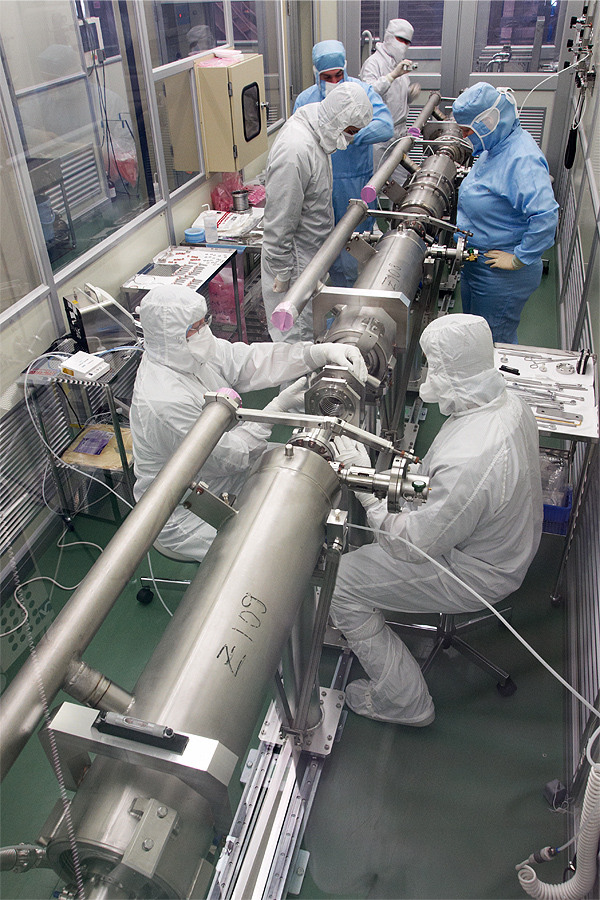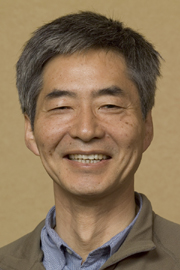Director's Corner
28 January 2010
S1 global started moving
Today's issue features a Director's Corner from Kaoru Yokoya, Global Design Effort Asian Regional Director.
S0, S1, and S2 — these are the "code names" for superconducting accelerating system R&D for the International Linear Collider. S0 is the programme to develop high-gradient superconducting cavities. Those cavities are the core element for ILC accelerator, but cavities only won't do the job. Other devices such as the couplers to send the microwave into the cavities, the tuners for precise frequency control, the vessel which is the container for the cavities to be cooled by liquid helium, the cryostat to house the whole cavity system, and the power generators, have to be developed as a system. This programme is called S1. S2 will follow S1, in which the accelerator unit with beam will be developed.
 String assembly of DESY and Fermilab cavities for the S1 global experiment on Day 3: assembling the two DESY cavities, Z109 and Z108, with standard-length bellows. Image: Nobu Toge String assembly of DESY and Fermilab cavities for the S1 global experiment on Day 3: assembling the two DESY cavities, Z109 and Z108, with standard-length bellows. Image: Nobu Toge |
The main objective of the S1 programme is to demonstrate the targetoperating gradient of 31.5 Megavolts per metre. In addition to that, one of the most important tasks for S1 is the demonstration of the feasibility to accelerate the beam in the system, which is constructed with components and parts made in different countries with different standards. In large international projects like the ILC, the development work has and will be done in many countries in parallel. It might seem ideal to develop all subcomponents everywhere in the world based on uniform standards from the very beginning of the project. But it is not only difficult, but it might cause limitation to the scientists' creativities for the new technologies. This is why we are working based on the plug-compatible approach, which allows for diversity that best suit variations that result from local conditions, and helps scientists keep their motivation for new innovative ideas. This approach also allows us to have some technical backup during the construction of the real accelerator.
Last week, the S1 programme being pursued by an international collaboration based on the plug-compatible concept for more than two years, called S1 global, has come to the real construction stage at KEK. Four cavities – two superconducting cavities from Fermilab, another two from DESY – delivered to KEK have been successfully assembled. Those cavities look alike, but subsystems such as couplers or tuners have very different feature, and the differences would be much greater than those for actual ILC accelerator. The accelerating gradients were nearly reached to our target through numerous tests including beam test at DESY's FLASH facility. This marked an important step towards not only S1, but also S2.
KEK received all components for this assemble work, the cryostat from INFN, Italy, four cavities, and necessary instruments (and even cleanroom ware) from Fermilab and DESY. Following those components, a strong team of five technicians arrived at KEK from Fermilab and DESY for assembly. They have completed the assembly work for the cavities from Europe and the US during their stay at KEK for just about one week, in collaboration with the KEK staff. I would like to thank the assemble team who visited KEK for their non-stop, tireless work over the weekend to accomplish the complex task. Also thanks to all colleagues' extended support that made this wonderful collaboration possible. Technical developments, such as achieving the cavity gradient or demonstrating plug-compatibility, are a very important factor for us towards realising the ILC. As well as those technology demonstration goals, the successful start of S1 global was meaningful in terms of the collaboration between laboratories around the world.
You can find the pictures of the S1 global work at ilc.kek.jp/photos/20100112Di and subsequent links you see there.
The series of work for S1 global will be continued for the rest of this year. The whole assemble work will be completed by June, and the system will be operated by the end of December.
-- Kaoru Yokoya
